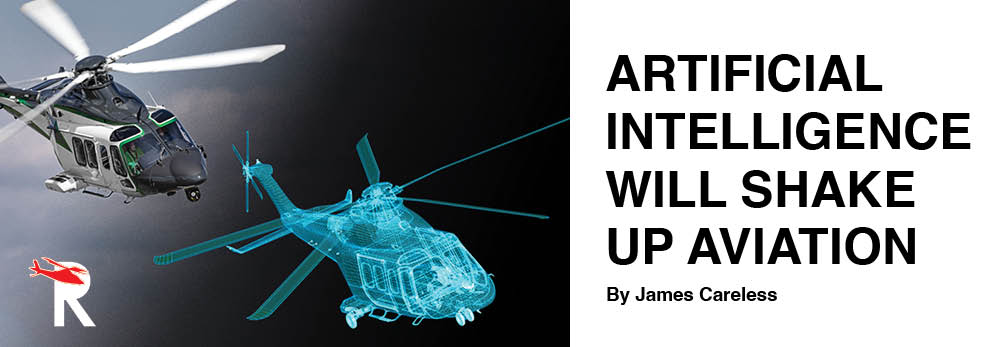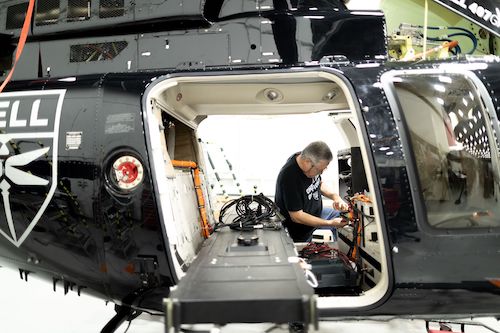|
Dec
18
2023
|
|
Posted 2 years 28 days ago ago by Admin
|
|

There’s a revolution underway in aviation, and it is being driven by artificial intelligence. AI is already affecting everything from helicopter/fixed-wing design and manufacturing to in-flight operations and maintenance, along with air traffic control and anything else that touches flying.
Impact Today
AI’s primary role with respect to aviation lies in “improving safety, efficiency and customer interactions,” said Grant Bristow, senior manager of enterprise software development at Bell Textron. “There are three notable areas where AI is making a difference: AI can improve manufacturing efficiency through generative design and additive manufacturing. AI technology can enable aircraft manufacturers and MRO services to monitor the health and condition of aircraft components and predict when they require repair or replacement. Advances in large language models (LLM) technology will enable companies like Bell to provide a more enriched experience for customers through interactive technical publications.”
That’s not all. Even today, “AI is enabling remote operation of uncrewed aircraft such as small UAS and military air vehicles,” said Clint Church, chief engineer at Aurora Flight Sciences, a Boeing company. “It is enabling more efficient data collection for use cases such as infrastructure inspection and intelligence, surveillance, and reconnaissance (ISR) missions.”
“Artificial intelligence is already playing a major role in many aspects of aviation,” agreed Simon Briceno, chief commercial officer at Jaunt Air Mobility. “Over the past several years, AI algorithms have been introduced into pilot training, flight operations, air traffic management, and passenger experiences. AI-driven flight simulators provide realistic training environments for pilots, helping them improve their skills and decision-making abilities. Finally, the use of AI algorithms has increased at airports in areas that screen passengers and baggage to identify security threats.”
“The value and beauty of AI resides in its role in ‘augmenting’ our intelligence and expanding opportunities to the benefit of all, tackling open-ended problems,” observed Leonardo Helicopters’ Mattia Cavanna, VP of technology and innovation. “It’s no surprise then that most advanced research centers and companies are equipped with high performance computers, such as Leonardo’s ‘Da Vinci-1’, paired with a growing Team of AI specialists within the so-called Leonardo labs hosting over a hundred Ph.D.s.”
More Impact Tomorrow
Just how far can AI go in aviation? That depends on two factors: The capabilities of this technology, and the degree to which humans will turn over control to computers.
“As we learn about AI, and how to test and verify its performance, it is conceivable that we will trust AI more and more, “ said Igor Cherepinsky, director of Sikorsky Innovations (Sikorsky is a Lockheed Martin company). “As such, we will hand over some flying tasks to the machine. In that sense, we can see AI becoming a digital copilot. Today, we have made good progress in that direction. For example, Sikorsky, in partnership with DARPA, has developed a digital copilot system that can even pilot the aircraft if needed.”

Bell Textron takes a similarly bullish view of AI’s role in aircraft operations. “AI is a critical part of achieving aircraft autonomy,” Bristow said. “It enables an aircraft to perform tasks without human intervention and limited supervision.”
Aurora Flight Sciences’ Church agreed with Bristow’s assessment, and described how autonomy will play a growing role across military and commercial applications. “For example, autonomy technology is being developed for self-flying air taxis that can takeoff, cruise, and land with oversight from multi-vehicle supervisors on the ground,” he said. “Autonomy software will manage real-world conditions including navigating around other air traffic and redirecting the air taxi’s flight path if an issue arises. As well, AI can provide predictable performance in non-collaborative aircraft situations and add an element of analytic redundancy.”
Based on the research underway at Bell Textron, AI will be able to play a major part in flight planning before takeoff, and situational awareness/decision-making once in flight.
On the ground, “AI can help aircraft operators evaluate plans and strategies for achieving their goals while also adapting to changing conditions and uncertainties, while considering various factors such as safety constraints, airspace restrictions and performance limitations,” said Bristow. Up in the air, this technology “can process and fuse the sensor data to create a comprehensive representation of the perceived environment including obstacles, hazards, weather, terrain and other aircraft. AI can also help aircraft respond to emergencies or contingencies such as system failures and malfunctions. AI-enabled systems can provide warnings, recommendations, or corrective actions to ensure the safety of the aircraft.”
AI can also reduce pilot workloads, said Dr. Kyriakos Vamvoudakis, Dutton-Ducoffe Endowed Professor at the Daniel Guggenheim School of Aerospace Engineering within the
Georgia Institute of Technology (Georgia Tech). “With AI, autopilot technology has evolved from simple devices that maintain an aircraft’s altitude and heading to fully autonomous flight control systems capable of performing gate-to-gate operations without any human input,” he noted.
This future is closer than one might think. At Leonardo, “we are introducing pilot safety solutions such as automatic landing spot detection and cable awareness, getting that extra layer of margin coming from data and information we were collecting but not using,” said Cavanna.
Then there’s aircraft maintenance and air traffic management: “AI algorithms can process and analyze vast amounts of data to identify potential safety issues and provide real-time monitoring of aircraft systems to help reduce maintenance costs,” Jaunt’s Briceno said “AI-powered collision avoidance systems are being introduced into new aircraft to help air traffic controllers manage traffic efficiently and prevent collisions, enhancing safety. Meanwhile, the use of AI algorithms in air traffic management helps predict the flight paths of aircraft, improving airspace utilization and enabling smoother traffic flow. Operators like airlines are reducing fuel consumption by using AI algorithms to optimize their flight routes and schedules.”
Going forward, AI will become an integral part of aviation education. “Through virtual and augmented reality technologies, AI will play a significant role in training pilots and air traffic controllers,” said Briceno. “Even today, AI algorithms are used and developed to analyze weather conditions, air traffic, and aircraft performance to optimize flight routes, saving fuel and time.”
.jpg?ver=XdGrGQmkP1IgFoeFcbcZdg%3d%3d)
And if this isn’t enough, AI will even affect how the aircraft of tomorrow will be created and flown. “On the design side, AI helps with weight and strength optimization of parts, wire routing, aerodynamic optimization,” Sikorsky Innovations’ Cherepinsky said. “With these advances, expect to see aircraft that are much more fuel efficient and contain fewer parts, i.e. are easier to maintain. On the operational side, as AI takes on more flying tasks, we expect pilot training requirements will be reduced. We expect humans to continue to be the managers of the mission, but actual flying will eventually be done by the machine.”
Finally, AI will transform the relationship between crewed and uncrewed aircraft. “
“In flying, we will see more teaming between aviators and uncrewed systems,” said Church. “That may mean a single, ground-based pilot overseeing multiple uncrewed aircraft in flight, or uncrewed vehicles co-operating with crewed vehicles to accomplish a shared mission.”
Possible Negatives
If every cloud has a silver lining, then the reverse must logically be true. All the benefits that AI can deliver to aviation may come with possible negatives that will have to be addressed.

One of these uncertain negatives is based on the fact that AI systems are ultimately created and coded by humans, with all the potential consequences associated with this reality.
“AI, although potent, itself suffers from many potential errors that can be caused by stochastic faults [due to the presence of random variables in its calculations], induced by malicious agents, or appear due to human errors,” said Dr. Kyriakos Vamvoudakis. “There are also considerations when it comes to implementing AI in aviation. One concern is the level of autonomy granted to AI systems. Striking a balance between automation and human control is crucial to ensure that pilots maintain their skills and decision-making abilities. Additionally, there are questions regarding the reliability of AI systems in critical situations or unforeseen circumstances. Rigorous testing and certification processes will be necessary before widespread adoption of AI-enabled flight technologies.”
Dr. Vamvoudakis isn’t alone in voicing concerns about AI. “Many advanced AI algorithms still require significant testing and evaluation for use in critical aspects of aviation, particularly those that affect the safe operation of aircraft,” Briceno said. “There are potential safety risks in the over-adoption of AI technologies without understanding the possible consequences when these technologies fail.”
Then there are the “unknown unknowns” described by former US Defense Secretary Donald Rumsfeld: “the ones we don't know we don't know.” The very newness of AI makes it difficult for humans to know how to assess its abilities fully, let alone trust it to take command. And then there is an unexplained phenomenon called “hallucinations” when AI programs simply get things wrong.
That’s right: For reasons still unknown by AI programmers, sometimes AI programs make things up when answering questions. Take this example from The New York Times’ 1 May 2023 article entitled, “When A.I. Chatbots Hallucinate”. The newspaper asked ChatGTP, “When did The New York Times first report on ‘artificial intelligence’?” ChatGTP replied that this occurred on 10 July 1956, in an article titled ‘Machines Will Be Capable of Learning, Solving Problems, Scientists Predict’, about a conference at Dartmouth College.
Here’s the problem: According to The Times, “The 1956 conference was real. The article was not. ChatGPT simply made it up.” The newspaper's first article on AI didn't come out until 1963.
In fairness to ChatGTP, the AI program may have sourced its answer from other web-based sources that were inaccurate but not visible to the newspaper. After all, The Times’ article said, “Because the internet is filled with untruthful information, the technology learns to repeat the same untruths.” Or as computer programmers like to say about faulty data being used to generate erroneous conclusions: Garbage in, Garbage out.
This being the case, regulators such as the FAA and EASA will have their hands full trying to assess which AI-enabled systems should be approved for use in aviation. As such, “the use of AI will pose challenges for certification due to new regulations needed for emerging technology,” said Bristow. Cavanna agreed, “There are many regulatory pieces that need to fall in place before adopting artificial intelligence at its full potential and in a safe manner in aviation. Setting clear guidance in terms of AI trustworthiness is quintessential. EUROCAE’s WG114/SAE G34 standard goes in that direction providing Process Standard for Development and Certification/Approval of Aeronautical Safety-Related Products implementing AI.”
Bottom Line
Like it or not, AI is the way of the future — not just for human society in general — but for aviation specifically. So the time to start working with AI — and get it right — is now. Perhaps we should ask ChatGPT how to improve its accuracy? Maybe.
READ MORE SEP/OCT ISSUE
READ MORE ROTOR PRO: https://justhelicopters.com/Magazine
WATCH ROTOR PRO YOUTUBE CHANNEL: https://buff.ly/3Md0T3y
You can also find us on
Instagram - https://www.instagram.com/rotorpro1
Facebook - https://www.facebook.com/rotorpro1
Twitter - https://twitter.com/justhelicopters
LinkedIn - https://www.linkedin.com/company/rotorpro1